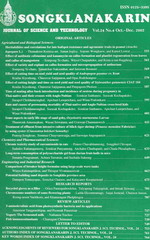ThaiScience
ThaiScience
SONGKLANAKARIN JOURNAL OF SCIENCE & TECHNOLOGY
Volume 42, No. 06, Month NOVEMBER, Year 2020, Pages 1215 - 1220
Species identification of forensically important fly larvae by integrating morphological characteristics and protein profiles
Pluemkamon Phuwanatsarunya , Nuttanan Hongsrichan , Tarinee Chaiwong , Marutpong Panya and Nophawan Bunchu
Abstract Download PDF
The correct identification of fly species has a crucial role in accurately performed forensic investigations. Species identification of fly larvae by observing only morphological characteristics is difficult and less accurate. Therefore, the objective of this study was to develop an alternative tool for identifying fly larvae by integrating morphological characteristics and protein expression profiles. Excretory-secretory (ES) protein profiles from third stage larvae of five fly species were evaluated to differentiate these species, including Chrysomya megacephala, Achoetandrus rufifacies, Lucilia cuprina, Musca domestica, and Boettcherisca nathani, based on the SDS-PAGE technique. They were also assessed for morphological characteristics. The results showed that different protein patterns in ES products and morphological characteristics were observed among these fly species. A novel dichotomous key for identification of fly larvae was developed by combining unique patterns of ES protein profiles with morphological characteristics. However, studies including other fly species should be pursued.
Keywords
excretory and secretory (ES), protein profile, third stage larva, identification, fliesSONGKLANAKARIN JOURNAL OF SCIENCE & TECHNOLOGY
Published by : Prince of Songkla University
Contributions welcome at : http://rdo.psu.ac.th
